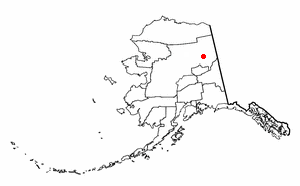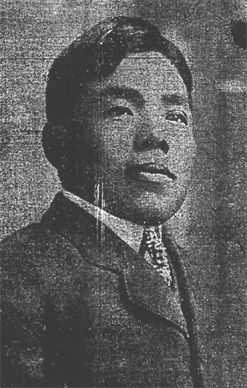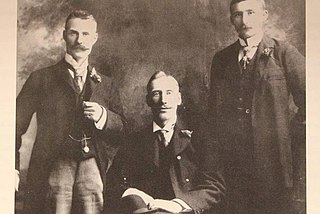
Nome is a city in the Nome Census Area in the Unorganized Borough of the US state of Alaska. The city is located on the southern Seward Peninsula coast on Norton Sound of the Bering Sea. It had a population of 3,699 recorded in the 2020 census, up from 3,598 in 2010. Nome was incorporated on April 9, 1901. It was once the most-populous city in Alaska. Nome lies within the region of the Bering Straits Native Corporation, which is headquartered in Nome.

Circle is a census-designated place (CDP) in Yukon-Koyukuk Census Area, Alaska, United States. At the 2020 census the population was 91, down from 104 in 2010.

A gold rush or gold fever is a discovery of gold—sometimes accompanied by other precious metals and rare-earth minerals—that brings an onrush of miners seeking their fortune. Major gold rushes took place in the 19th century in Australia, Greece, New Zealand, Brazil, Chile, South Africa, the United States, and Canada while smaller gold rushes took place elsewhere.

The District of Alaska was the federal government’s designation for Alaska from May 17, 1884, to August 24, 1912, when it became the Territory of Alaska. Previously (1867–1884) it had been known as the Department of Alaska, a military designation.
This article discusses transportation in the U.S. state of Alaska.

Chena was a former city in interior Alaska, located in the Fairbanks North Star Borough, Alaska, United States, near the confluence of the Chena and Tanana rivers. It incorporated in 1903 and was disincorporated in 1973. The area is now part of the outskirts of Fairbanks, within the CDP of Chena Ridge. Its heyday was in the first two decades of the 20th century, with a peak population of about 400 in 1907. By 1910 the population had fallen to 138.

Jafet Lindeberg was a gold prospector and co-founder of the city of Nome, Alaska.

Jujiro Wada was a Japanese adventurer and entrepreneur who achieved fame for his exploits in turn-of-the-20th-century Alaska and Yukon Territory.
Gold mining in Alaska, a state of the United States, has been a major industry and impetus for exploration and settlement since a few years after the United States acquired the territory in 1867 from the Russian Empire. Russian explorers discovered placer gold in the Kenai River in 1848, but no gold was produced. Gold mining started in 1870 from placers southeast of Juneau, Alaska.

Isadore "Ike" Bayles was an Alaskan businessman and considered one of the founding fathers of Anchorage, Alaska. He was part of the Klondike Gold Rush and the Fairbanks Gold Rush where he set up businesses to service the gold rushers. He set up a clothing business in Fairbanks around 1905 and was active in the first Jewish congregation in the area. He was also part of the Iditarod gold rush, where he established the Bayles Clothing Company with locations in Iditarod and Discovery. Eventually, he created the Jaffe & Bayles Leading Clothier, and it was one of the first businesses in Anchorage.

The Fairbanks Gold Rush was a gold rush that took place in Fairbanks, Alaska in the early 1900s. Fairbanks was a city largely built on gold rush fervor at the turn of the 20th century. Discovery and exploration continue to thrive in and around modern-day Fairbanks.

The history of Fairbanks, the second-largest city in Alaska, can be traced to the founding of a trading post by E.T. Barnette on the south bank of the Chena River on August 26, 1901. The area had seen human occupation since at least the last ice age, but a permanent settlement was not established at the site of Fairbanks until the start of the 20th century.

Erik Lindblom (1857-1928) was a Swedish-American gold prospector. He was one of the "Three Lucky Swedes" who founded and developed the Nome mining district.

John Brynteson was one of the "Three Lucky Swedes" who founded and developed the Nome mining district.

The Nome Gold Rush was a gold rush in Nome, Alaska, approximately 1899–1909. It is separated from other gold rushes by the ease with which gold could be obtained. Much of the gold was lying in the beach sand of the landing place and could be recovered without any need for a claim. Nome was a sea port without a harbor, and the biggest town in Alaska.

Carrie Mary McLain was an American writer and teacher known for her histories and memorabilia of Alaska.
William Earnest Beltz was an American politician and carpenter.
The history of the Jews in Alaska began before the Alaska Purchase in 1867. Jews from Imperial Russia lived there periodically as fur traders, and a Jewish community has existed since the 1880s. The Klondike and Nome gold rushes attracted Jews to Alaska to seek their fortunes as miners and businessmen and resulted in the first organized Jewish communities. In the Nazi period, Jewish refugee resettlement in Alaska was seriously considered by the government, but after facing backlash, never came to be. Alaskan Jews played a significant role in business and politics before and after statehood, and have included mayors, judges, senators and governors. Today, there are Jews living in every urban area of the state.

Portus B. Weare was a wooden sternwheel steamship built in 1892 for service on the Yukon River. She played a notable role in the Klondike gold rush, being the second ship to bring news of the Klondike gold strike and an estimated $1 million in gold down the river in 1897. This set off the gold rush. The vessel carried freight and passengers up the Yukon to Dawson City and later Fairbanks. She was abandoned in 1926 or 1927, after the need for steamboat transport to the interior declined.

Senator was a steel-hulled steamship launched in 1898. She served as a troopship during the Spanish-American War and was an important part of the Nome gold rush. She spent thirty years in the coastwise shipping trade between Alaska and San Diego, until she was scrapped in Osaka, Japan in 1935.














